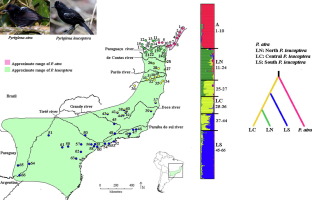当前位置:
X-MOL 学术
›
Mol. Phylogenet. Evol.
›
论文详情
Our official English website, www.x-mol.net, welcomes your feedback! (Note: you will need to create a separate account there.)
Vicariance, dispersal, extinction and hybridization underlie the evolutionary history of Atlantic forest fire-eye antbirds (Aves: Thamnophilidae).
Molecular Phylogenetics and Evolution ( IF 4.1 ) Pub Date : 2020-04-10 , DOI: 10.1016/j.ympev.2020.106820 Manuelita Sotelo-Muñoz 1 , Marcos Maldonado-Coelho 2 , Maria Svensson-Coelho 2 , Sidnei S Dos Santos 3 , Cristina Y Miyaki 1
Molecular Phylogenetics and Evolution ( IF 4.1 ) Pub Date : 2020-04-10 , DOI: 10.1016/j.ympev.2020.106820 Manuelita Sotelo-Muñoz 1 , Marcos Maldonado-Coelho 2 , Maria Svensson-Coelho 2 , Sidnei S Dos Santos 3 , Cristina Y Miyaki 1
Affiliation

|
In order to gain insights into the biogeographic processes underlying biotic diversification in the Atlantic Forest (AF), we used a multi-locus approach to examine the evolutionary history of the White-shouldered Fire-eye (Pyriglena leucoptera) and the Fringe-backed Fire-eye (Pyriglena atra), two parapatric sister species endemic to the AF. We sequenced one mitochondrial, three Z chromosome-linked and three anonymous markers of 556 individuals from 66 localities. We recovered four lineages throughout the AF: P. atra and three populations within P. leucoptera. All populations diverged during the late Pleistocene and presented varying levels of admixture. One Z-linked locus showed the highest level of differentiation between the two species. On the other hand, a mitochondrial haplotype was shared extensively between them. Our data supported vicariance driving speciation along with extinction and dispersal as processes underlying intraspecific diversification. Furthermore, signatures of demographic expansion in most populations and areas of genetic admixture were recovered throughout the AF, suggesting that forest fragmentation was also important in differentiation. Genetic admixture areas are located between large rivers suggesting that AF rivers may diminish gene flow. Our results indicated a complex and dynamic biogeographic history of Pyriglena in the AF, with vicariance, extinction, dispersal and secondary contact followed by introgression likely influencing the current patterns of genetic distribution.
中文翻译:

差异性,扩散性,灭绝性和杂交性是大西洋森林火眼蚂蚁(Aves:Thamnophilidae)进化史的基础。
为了深入了解大西洋森林(AF)中生物多样性背后的生物地理过程,我们使用了多位点方法来研究白肩火眼(Pyriglena leucoptera)和边缘支持火的进化历史。眼(Pyriglena atra),AF特有的两个同胞姐妹种。我们对来自66个地区的556个个体的1个线粒体,3个Z染色体连锁和3个匿名标记进行了测序。我们在整个AF中恢复了四个血统:P。atra和P. leucoptera中的三个种群。在更新世晚期,所有种群都出现分歧,并呈现出不同程度的混合。一个Z连锁基因座显示了两个物种之间最高的分化水平。另一方面,线粒体单体型在它们之间广泛共享。我们的数据支持变异推动物种形成,同时物种灭绝和扩散是种内物种多样化的基础。此外,在整个AF中,大多数人口和遗传混合区域的人口膨胀特征都得到了恢复,这表明森林破碎化在分化中也很重要。遗传混合区位于大河之间,表明AF河可能会减少基因流量。我们的研究结果表明,AF上的毛霉菌属具有复杂而动态的生物地理历史,变异,灭绝,扩散和二次接触随后渗入可能影响当前的遗传分布方式。在整个AF中,大多数人口和遗传混合区域的人口膨胀特征都得到了恢复,这表明森林破碎化在分化中也很重要。遗传混合区位于大河之间,表明AF河可能会减少基因流量。我们的研究结果表明,AF上的毛霉菌属具有复杂而动态的生物地理历史,变异,灭绝,扩散和二次接触随后渗入可能影响当前的遗传分布方式。在整个AF中,大多数人口和遗传混合区域的人口膨胀特征都得到了恢复,这表明森林破碎化在分化中也很重要。遗传混合区位于大河之间,表明AF河可能会减少基因流量。我们的研究结果表明,AF上的毛霉菌属具有复杂而动态的生物地理历史,变异,灭绝,扩散和二次接触随后渗入可能影响当前的遗传分布方式。
更新日期:2020-04-13
中文翻译:

差异性,扩散性,灭绝性和杂交性是大西洋森林火眼蚂蚁(Aves:Thamnophilidae)进化史的基础。
为了深入了解大西洋森林(AF)中生物多样性背后的生物地理过程,我们使用了多位点方法来研究白肩火眼(Pyriglena leucoptera)和边缘支持火的进化历史。眼(Pyriglena atra),AF特有的两个同胞姐妹种。我们对来自66个地区的556个个体的1个线粒体,3个Z染色体连锁和3个匿名标记进行了测序。我们在整个AF中恢复了四个血统:P。atra和P. leucoptera中的三个种群。在更新世晚期,所有种群都出现分歧,并呈现出不同程度的混合。一个Z连锁基因座显示了两个物种之间最高的分化水平。另一方面,线粒体单体型在它们之间广泛共享。我们的数据支持变异推动物种形成,同时物种灭绝和扩散是种内物种多样化的基础。此外,在整个AF中,大多数人口和遗传混合区域的人口膨胀特征都得到了恢复,这表明森林破碎化在分化中也很重要。遗传混合区位于大河之间,表明AF河可能会减少基因流量。我们的研究结果表明,AF上的毛霉菌属具有复杂而动态的生物地理历史,变异,灭绝,扩散和二次接触随后渗入可能影响当前的遗传分布方式。在整个AF中,大多数人口和遗传混合区域的人口膨胀特征都得到了恢复,这表明森林破碎化在分化中也很重要。遗传混合区位于大河之间,表明AF河可能会减少基因流量。我们的研究结果表明,AF上的毛霉菌属具有复杂而动态的生物地理历史,变异,灭绝,扩散和二次接触随后渗入可能影响当前的遗传分布方式。在整个AF中,大多数人口和遗传混合区域的人口膨胀特征都得到了恢复,这表明森林破碎化在分化中也很重要。遗传混合区位于大河之间,表明AF河可能会减少基因流量。我们的研究结果表明,AF上的毛霉菌属具有复杂而动态的生物地理历史,变异,灭绝,扩散和二次接触随后渗入可能影响当前的遗传分布方式。



























 京公网安备 11010802027423号
京公网安备 11010802027423号